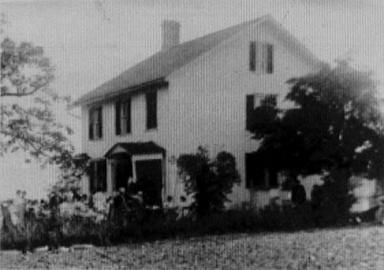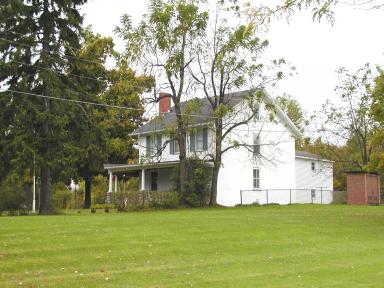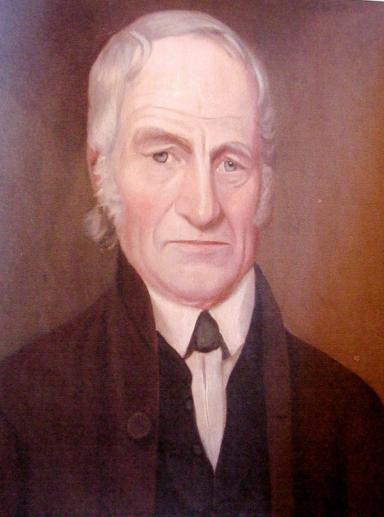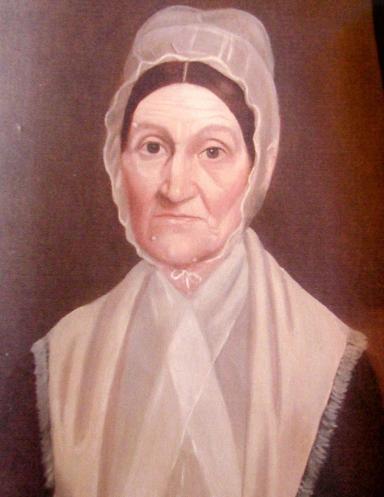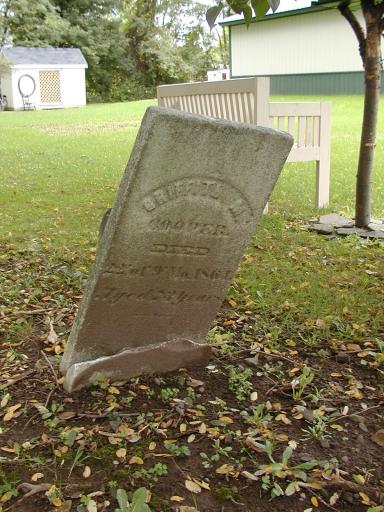If you find errors OR have additional information about this site, please send a message to contact@waynehistorians.org.
Underground RR Station NYS Hist Marker/Griffith and Eliza Cooper
| Historic Site #: | 14-008 (Exists) Type: B2,F2 | Town: | Williamson | ||
| Site Name: | Underground RR Station NYS Hist Marker/Griffith and Eliza Cooper | GPS Coordinates: | 43.211613, -77.192418 | ||
| Address: | 5825 Rt. 21 Williamson New York | ||||
| Description: | |||||
| In the 19th century this was the home of Griffith and Eliza Cooper, Quakers, who as abolitionists secreted runaway slaves in their home before they were transported to other stations further north in Pultneyville. Frederick Douglass stayed in the Cooper house and often referred to Cooper in print, calling him “the veteran friend of the Indian as well as the African”. | |||||
| 🔊Audio: Tour Sound Bite |
| Historic narrative: | |||||
Description: Griffith and Elizabeth Cooper migrated to upstate New York from New Jersey, and the family’s house reflected vernacular forms from that region. According to local tradition, this three-bay stone house (later covered with stucco) was built in 1838. The building is virtually square. Giles B. Stebbins, fellow reformer and friend of the Coopers, noted that it was built “after the Pennsylvania style.” Local people describe odd spaces in the attic, not accessible from the main attic space, and speculate that the house may have been purposefully built to hide people escaping from slavery. Set back from the road, once surrounded by barns and orchards, the Cooper house is now in the middle of a grassy lawn, with woods on the south side and Williamson School on the north. Across the road, Griffith Cooper lies buried in a Quaker cemetery, near the site of the meetinghouse for Williamson Preparative Meeting (part of Farmington Monthly Meeting) where he served as minister. Except for a few changes in the late nineteenth century (a wide front porch that replaces the earlier small roof over the front door and windows with some stained glass at the top), the Cooper house is in virtually original condition. It is not known whether the stucco is original. The house has remained a private home since the time of the Cooper family’s ownership. A New York State historical marker stands in front of the Cooper home. Discussion: Griffith M. Cooper (1791-1864) with his wife Elizabeth Hodgson Cooper (1790-1873), Quakers associated with Farmington (New York) Monthly Meeting of Friends (Hicksite), kept a major Underground Railroad station linked to stations in Farmington and Palymra (fifteen miles south), Pultneyville (ten miles north on Lake Ontario), and Frederick Douglass and Amy Post in Rochester (twenty-five miles west). Griffith Cooper’s national Underground Railroad activity was connected to his work with the American Anti-Slavery Society, the Western New York Anti-Slavery Society, and the Indian Committees of Baltimore, Philadelphia, New York, and Genesee Yearly Meetings of Friends, which linked him with Friends in Baltimore, Philadelphia, and New York City. From 1848 until his death in 1864, Griffith Cooper was associated with the Congregational Friends (Friends of Human Progress). Evidence for his Underground Railroad work is clear. In 1852, Cooper wrote a letter to Frederick Douglass Paper, reporting to his “Esteemed Friend” Douglass, that “three emigrants, from the South, via Rochester, left our port for Queen Victoria’s dominions, the 19th inst., at 8:00 p.m., with three hearty cheers for the land of the free, the home of the exile. . . .The underground railroad is in successful operation. Thine for emigration, North.” In 1895, at the time of Douglass’ death, an article in the Rochester Democrat and Chronicle noted that three men escaping from slavery were taken to the home of Griffith Cooper, where they remained in hiding before they were dressed in women’s clothes and then sent to Canada via the port of Pultneyville (February 22, 1895). Douglass stayed in the Cooper house and often referred to Cooper in print, calling him “the veteran friend of the Indian as well as the African” (North Star, March 3, 1848) and “the man widely known as the self sacrificing friend of Humanity,” (Frederick Douglass’ Paper, December 2, 1853). Cooper, Abolitionism, and the Underground Railroad The History of Wayne County noted that African Americans escaping from slavery came to Griffith Cooper in Williamson, William R. Smith in Macedon, or Dr. Cook in Sodus. Cooper sent them to Samuel C. Cuyler in Pultneyville, on Lake Ontario. Cooper also sent them to Frederick Douglass (and probably Quaker Amy Post) in Rochester. William R. Smith was an Orthodox Quaker from Farmington; Cooper was a Hicksite Friend. Cooper’s Underground Railroad activity was firmly rooted in his larger commitment to abolitionist organizing. In February 1848, he helped organized an antislavery meeting in the Baptist and Methodist churches in Williamson, where speakers included African Americans Frederick Douglass and Charles Lenox Remond and Quakers Giles B. Stebbins and J.C. Hathaway, all affiliated with the American Anti-Slavery Society. Frederick Douglass reported that the meeting was “truly a bright and spirited one.” Charles Lenox Remond gave “a most impassioned and eloquent address, designed to show that the Anti-Slavery cause was the white, as well as the black man’s cause.” “Men, women and children, age, youth and beauty, were there, and all alive in the cause of freedom. It was truly heart-cheering to look out upon the warm-hearted assemblage.” Griffith M. Cooper, noted Douglas, “the veteran friend of the Indian, as well as the African, aided, with sympathy, hospitality and money, to help the cause along.” Cooper was appointed a member of the Executive Committee of the Western New York Anti-Slavery Society in December 1848. When women of Williamson organized an antislavery fair in January 1849, Griffith Cooper introduced their featured speaker, John S. Jacobs, sister of Harriet Jacobs, who later wrote Incidents in the Life of a Slave Girl. Both John S. Jacobs and Harriet Jacobs had escaped from slavery in Edenton, North Carolina. Frederick Douglass was also a speaker at that meeting. In September 1849, Cooper spoke, along with Frederick Douglass, at a meeting in Marion, Wayne County. When Abby Kelley Foster and Stephen Foster came through western New York in 1852, Cooper organized an antislavery convention in Williamson on March 22-23 “at the meetinghouse formerly occupied by the Society of Friends.” Wesleyan, Presbyterian, and Baptist churches all held a “protracted meeting,” i.e. a revival, instead of allowing this convention. Debate centered on the contention that “the church is mainly responsible for the continuance of this most atrocious and abhorrent system [of slavery],” and “the best means of accomplishing this work, is the faithful preaching of the truth, and not by the action of political parties.” Although Samuel C. Cuyler, keeper of the next Underground Railroad to the north was a major political abolitionist, the meeting affirmed Cooper’s own idea that “a sectarian Religion will always, in the trying hour, prove untrue to Liberty.” Griffith Cooper sent the notice of this convention to the National Anti-Slavery Standard with the note that the Wesleyan Methodists had read the notice of the meeting, “as a special favour,” “and then desired, or, in other words, prohibited, ‘all praying souls’ from attending it. Such is the character of all such religion—it abounds in faith, but works are left for those, whom they denounced as Infidels. Thine for the slave. G.M. Cooper.” At the eighteenth anniversary of the American Anti-Slavery Society, held at Corinthian Hall in Rochester in May 1852, and chaired by William Lloyd Garrison, Cooper was elected a manager. Griffith Cooper died in Williamson on September 22, 1864, having been in ill health for some time. The Pultneyville Commercial Press printed a memorial passed at the annual meeting of the Friends of Human Progress: Since our last meeting Griffith M. Cooper, a venerable man, ripe in wisdom and experience, who has been with us, at times in person, always in spirit and desire, has passed on to a higher life. Through a long and varied career; as a Naval Officer, as a preacher of the Society of Friends, as a guardian of the Indians on the Cattaraugus Reservation from the rapacity of speculators, (employed in the capacity by the society of which he was a member), as an early and faithful advocate of Freedom, Peace and Temperance, as a reformer, stepping beyond the limits of sect, and transcending the bounds of arbitrary authority, he sought to be true to his own light. His clear, and frank, and faithful word was ready in public or private for the best truth he knew and felt. We offer this brief testimonial to the genial qualities, and manly virtues of a much-beloved friend, who, his course on earth well finished, has gone to meet those of his dear family "not lost but gone before.” Griffith M. Cooper was buried in the Quaker cemetery on the corner of Route 21 and Pearsall Road, across the street from his home. Elizabeth Hodgson Cooper died April 1, 1873, in New Orleans, Louisiana. | |||||
Uncovering the Underground Railroad, Abolitionism, and African American Life in Wayne County, New York, 1820-1880 pp 375 - 388
Frederick Douglass YouTube Video

